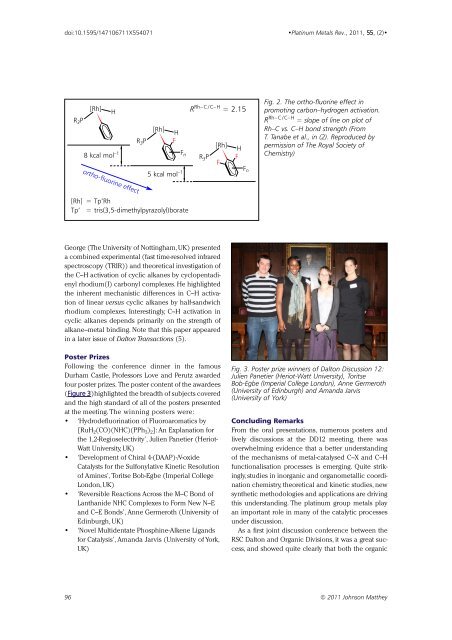Download - Platinum Metals Review
Download - Platinum Metals Review
Download - Platinum Metals Review
Create successful ePaper yourself
Turn your PDF publications into a flip-book with our unique Google optimized e-Paper software.
doi:10.1595/147106711X554071<br />
•<strong>Platinum</strong> <strong>Metals</strong> Rev., 2011, 55, (2)•<br />
[Rh]<br />
H<br />
R 3 P<br />
[Rh]<br />
H<br />
R 3 P F<br />
8 kcal mol –1 5 kcal mol –1<br />
F n<br />
R Rh–C/C–H = 2.15<br />
[Rh]<br />
R 3 P<br />
F<br />
H<br />
F<br />
F n<br />
Fig. 2. The ortho-fluorine effect in<br />
promoting carbon–hydrogen activation.<br />
R Rh–C/C–H = slope of line on plot of<br />
Rh–C vs. C–H bond strength (From<br />
T. Tanabe et al., in (2). Reproduced by<br />
permission of The Royal Society of<br />
Chemistry)<br />
ortho-fluorine effect<br />
[Rh] = Tp’Rh<br />
Tp’ = tris(3,5-dimethylpyrazolyl)borate<br />
George (The University of Nottingham, UK) presented<br />
a combined experimental (fast time-resolved infrared<br />
spectroscopy (TRIR)) and theoretical investigation of<br />
the C–H activation of cyclic alkanes by cyclopentadienyl<br />
rhodium(I) carbonyl complexes. He highlighted<br />
the inherent mechanistic differences in C–H activation<br />
of linear versus cyclic alkanes by half-sandwich<br />
rhodium complexes. Interestingly, C–H activation in<br />
cyclic alkanes depends primarily on the strength of<br />
alkane–metal binding. Note that this paper appeared<br />
in a later issue of Dalton Transactions (5).<br />
Poster Prizes<br />
Following the conference dinner in the famous<br />
Durham Castle, Professors Love and Perutz awarded<br />
four poster prizes. The poster content of the awardees<br />
(Figure 3)highlighted the breadth of subjects covered<br />
and the high standard of all of the posters presented<br />
at the meeting.The winning posters were:<br />
• ‘Hydrodefluorination of Fluoroaromatics by<br />
[RuH 2 (CO)(NHC)(PPh 3 ) 2 ]: An Explanation for<br />
the 1,2-Regioselectivity’, Julien Panetier (Heriot-<br />
Watt University, UK)<br />
• ‘Development of Chiral 4-(DAAP)-N-oxide<br />
Catalysts for the Sulfonylative Kinetic Resolution<br />
of Amines’, Toritse Bob-Egbe (Imperial College<br />
London, UK)<br />
• ‘Reversible Reactions Across the M–C Bond of<br />
Lanthanide NHC Complexes to Form New N–E<br />
and C–E Bonds’, Anne Germeroth (University of<br />
Edinburgh, UK)<br />
• ‘Novel Multidentate Phosphine-Alkene Ligands<br />
for Catalysis’, Amanda Jarvis (University of York,<br />
UK)<br />
Fig. 3. Poster prize winners of Dalton Discussion 12:<br />
Julien Panetier (Heriot-Watt University), Toritse<br />
Bob-Egbe (Imperial College London), Anne Germeroth<br />
(University of Edinburgh) and Amanda Jarvis<br />
(University of York)<br />
Concluding Remarks<br />
From the oral presentations, numerous posters and<br />
lively discussions at the DD12 meeting, there was<br />
overwhelming evidence that a better understanding<br />
of the mechanisms of metal-catalysed C–X and C–H<br />
functionalisation processes is emerging. Quite strikingly,<br />
studies in inorganic and organometallic coordination<br />
chemistry, theoretical and kinetic studies, new<br />
synthetic methodologies and applications are driving<br />
this understanding. The platinum group metals play<br />
an important role in many of the catalytic processes<br />
under discussion.<br />
As a first joint discussion conference between the<br />
RSC Dalton and Organic Divisions, it was a great success,<br />
and showed quite clearly that both the organic<br />
96 © 2011 Johnson Matthey
















